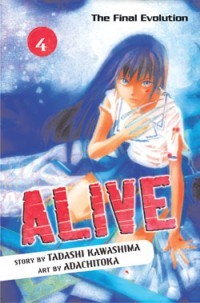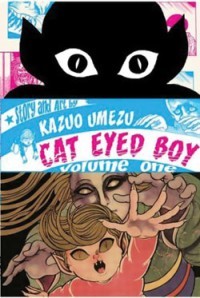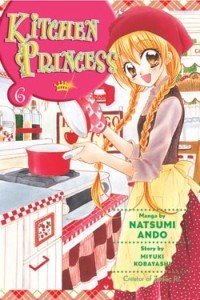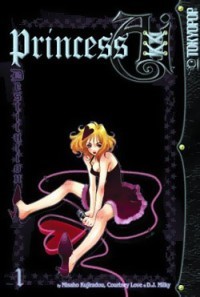RIGHT TURN ONLY!!
Hell's Kitchen
by Carlo Santos,

These are strange times we are living in. Tokyopop on the fritz! (Have you heard what people have been saying about Stu Levy?) Kodansha threatening to make a move! Five dollar gasoline! Lakers and Celtics in the NBA Finals! Cats and dogs living together!
I'm afraid to turn on my faucets for fear that they will start running with blood.
ALIVE

Vol. 4
(by Tadashi Kawashima and Adachitoka, Del Rey, $10.95)
FROM THE BACK COVER:
"Taisuke and Yuta encounter to more superpowered 'comrades.' Nami can create ice daggers and wield them as weapons, while anyone who breaks a promise made to the vengeful Okada dies instantly. But whose side are they on? Meanwhile, Inspector Katsumata and his followers travel to Hokkaido in search of the mysterious 'Acro's Heart,' the key to the entire superpower revolution."
EVIDENCE FOR:
What's more terrifying than a Death Note? How about a guy who can wish death upon you verbally? The latest volume of Alive proves that there's still plenty of surprises in store, as we meet even more characters with uncanny powers. The "Grim Reaper's Promise" of Okada is not just a psychological trip, but a visual one as well: the imagery of a scythe-swinging angel of death, coupled with the victim's own hallucinations, is chilling in its detail and elegance. And as for Okada himself being a rude, sweaty otaku—well, that's just an amusing touch of character design. The addition of vengeful Nami to Taisuke and Yuta's party also brings some interesting moral ambiguity to the mix. Meanwhile, the main story finally advances past the old meet-a-villain-and-fight formula—the emergence of Hokkaido as a target location guarantees that things are, quite literally, going somewhere. Long chapters allow plenty of room for layout, and once again there are some brilliant blow-by-blow fight scenes here. If there's one image that's going to stick, though, it's the Reaper emerging right after you've broken a promise...
EVIDENCE AGAINST:
The Nami section of the book: about twice as long as it needed to be. Yes, it's kind of cool to see an ice-user going up against a fire-user, but really, that got played out in X-Men, and the aftermath of the battle is a near-exact replay of what happened back when Yuta joined up with Taisuke. Cue flashback to the time Nami lost a dear relative, gained her powers and swore vengeance, which is such a typical course of action that describing what happened hardly counts as spoiler material. A later scene with Nami, her mother and Yuta also wastes valuable space; it may provide a gentle pull on the heartstrings, but the thing that needs pulling right now is the plot. In the right direction. The details about the Acro's Heart in Hokkaido are a good start, but the bad guys and the reporters on the trail still aren't getting enough face time. Come on! Tell us what's going on behind the scenes already!
FINAL VERDICT:
Things start to get a bit stale at times, but there are still enough new characters and new ideas to keep the suspense and action up to a B.
CAT EYED BOY

Vol. 1
(by Kazuo Umezu, Viz Media, $24.99)
FROM THE BACK COVER:
"A chilling concoction of dark vignettes dripping with the macabre, the grotesque and the absurd. Hated by humans and demons alike, Cat Eyed Boy dwells in the shadows of the human world. No matter where he goes, terrifying situations involving humans and demons begin to unfurl."
EVIDENCE FOR:
Whatever you might be afraid of, Kazuo Umezu's got it covered. Insects? Natural disasters? Unnatural childbirth? The dead and the undead? It's all here in this bumper 500-page volume (perhaps the only phobia it's missing is public speaking). These stories are at their best when they take the psychological route, preying on our deepest paranoias and fears of the unknown: the idea that someone is out to get you and your family, or that there's something lurking in the woods, or that you might suddenly develop a horrible bodily deformity. Questions of morality and human nature also arise—notice how Cat Eyed Boy does not side with either humans or monsters, and how people we might consider "good" or "attractive" often have a dark side. But what is even more terrifying is when someone who's already ugly becomes even uglier in their heart. Deep shading and gruesomely designed monsters make this a true work of horror; all it takes is bending the laws of nature to come up with something seriously creepy. With uncompromising scenes and striking images, Umezu is on a mission to freak you out—and usually he succeeds.
EVIDENCE AGAINST:
While any of Umezu's output is generally considered "classic," some things about the classics don't age very well. The paneling may be straightforward, but it also comes off as rather stiff, sectioning every scene into generic rectangles. The old-school character designs also take away from the horror effect, reminding us with shiny eyes and contrived poses that these are still just illustrations. Even the monsters lose their scariness from time to time, looking more like Fraggle Rock extras than fearsome creatures. It's a thin line between creepy and humorous, folks. Sometimes the stories themselves also lack focus: "The Tsunami Summoners" serves as an origin story for the Cat Eyed Boy but wanders in all sorts of plot directions, "The One-Legged Monster of Oudai" can't seem to decide who its main character is, and the epic "Band of One Hundred Monsters" forces this volume to end on a cliffhanger. Now that's annoying.
FINAL VERDICT:
Nobody sets a horror mood better than Kazuo Umezu, but the archaic style and less-than-perfect storytelling leave this volume at a B-.
CLAYMORE

Vol. 12
(by Norihiro Yagi, Viz Media, $7.99)
FROM THE BACK COVER:
"In a world where monsters called Yoma prey on humans and live among them in disguise, humanity's only hope is a new breed of warrior known as Claymores. Half human, half monster, these silver-eyed slayers possess supernatural strength but are condemned to fight their savage impulses—or lose their humanity completely.
Seven years have passed since the devastating battle in Pieta, and now a new generation of warriors carries on the fight against the Awakened Ones. However, the mystery of Clare's fate, and that of her comrades, resurfaces after a surprising discovery made by a young Claymore."
EVIDENCE FOR:
So, you thought storyline time-skips were only for orange-clad boy ninjas? Think again! The epic fantasy world of Claymore moves on to a new era, but the echoes of the Battle of Pieta still hang heavy over the series. Certainly, this is a much more solemn affair than last volume, but the power of reminiscence and regret has its own unique impact. Just look at the sight of all the Claymore swords laid as grave markers, or the wistful words of the survivors, or the flashback that tells of the terrible sacrifices from seven years ago. On the action side, the flashy fighting techniques of the new Claymore generation might come as a bit of a shock to the old guard. What does not come as a shock, however, is that Norihiro Yagi's artwork is as consistent and detailed as ever, bringing sweeping landscapes and fearsome monsters to life. As always, the page layouts are spaced just right, moving along like a classic heroic saga and pausing occasionally for a dazzling sword attack or some striking scenery. Of all the "serious" fantasy adventures out there, this is the one that does it without being cheesy or cliché.
EVIDENCE AGAINST:
Although this volume's central "Souls of the Fallen" arc is a strong one, things do not begin or end very well. The first chapter is a leftover from the previous arc, and even more confusing than that, it's mostly flashback material. Meanwhile, at the tail end of the book, the two-part "The Defiant Ones" ends things on an unsatisfying cliffhanger, and that's after seeing several pages of brutish, mindless action. Sure, it's very pretty action, but it just doesn't feel as epic or creative as when Clare and friends used to do it. So basically there's not a whole lot of swordfighting in this one (the middle chapters are mostly talking and flashbacks), and the swordfighting that does exist is subpar by this series' standards. Not very encouraging, eh? And since there's not enough eyecandy to distract the reader, certain artistic flaws become apparent, like the overuse of gray, the fact that all the Claymores have the same dead eyes, and it's still a chore telling all the girls apart.
FINAL VERDICT:
Obviously not as epic as the Battle of Pieta last volume, and the beginning and ending chapters are kind of lame, but the heart-stirring events in the middle are still worthy of a B-.
KITCHEN PRINCESS

Vol. 6
(by Miyuki Kobayashi and Natsumi Ando, Del Rey, $10.95)
FROM THE BACK COVER:
"Najika's dreams are coming true! She's in the finals of a national dessert contest and she has found her Flan Prince. But then life goes from sweet to sour, as she makes a startling discovery and loses her sense of taste!"
EVIDENCE FOR:
Okay ... it will be very hard to discuss this volume without going into MAJOR SPOILERS. Let's just say, this is the best Kitchen Princess yet, and completely validates why the series won a Kodansha Manga Award. Remember when I said that the Najika/Sora/Daichi relationship was going to turn into a totally predictable love triangle? I am happy to say that I was completely wrong. The plot revelations in this volume are monumental and heartbreaking, and anyone with the slightest weakness for sappy shoujo will be bawling like a baby, guaranteed. Of all the things that happen, Najika's change in character is the most saddening of all—her desperation in the face of tragedy, the shock of losing her absolute sense of taste, and how the world around her changes after the events of the competition. This is the best kind of emotional rollercoaster ride, where they put you through unbelievable lows so that even the slightest glimmer of hope feels all the more powerful. And with the layouts so cleanly spaced and the artwork easy to follow, the story flows effortlessly from scene to scene. Love, heartbreak, redemption—who knew that a "little girls' manga" could be this good.
EVIDENCE AGAINST:
There's just one little problem with the major plot point of this volume: it's highly improbable. Seriously, that happens to a person, and it's immediately followed by that other thing? That's a real test of one's suspension of disbelief. And then there are the improbable overreactions from other characters, like the entire school turning on Najika and her decision to run away yet again. It's true that the series runs on powerful emotions, but those emotions just overdo it at times. Also overdoing it are the number of big googly-eye faces that make up the artwork—yes, that's just the way it is for this style and genre, but after a while they all start to look the same. The common use of screentone-patterned backgrounds also suggests a touch of artistic laziness.
FINAL VERDICT:
Why is this not as popular as Full Moon or Fruits Basket? The level of drama is just as good, and this heartbreaking A- volume proves it.
PARASYTE

Vol. 3
(by Hitoshi Iwaaki, Del Rey, $12.95)
FROM THE BACK COVER:
"Alien parasites have invaded Earth and taken over the minds of ordinary people. Shin has been infected with a parasite, but he still can think and act for himself. Now he's been approached by two mysterious victims of the invasion: Tamiya, a beautiful schoolteacher, and Shimada, another student. What do the aliens want with humanity ... and with Shin?"
EVIDENCE FOR:
After treating us to two thick volumes of freakish alien transformations, the third installment of Parasyte reveals the scariest transformation yet: the one going on in Shinichi's mind. From a typical high school boy to a heartless beast who's starting to think like the creature inside him ... that's when people should really start worrying. What's really impressive is how all the little things in the story add up to big changes: the way Shin treats a dead animal, a passing comment from his father, and most tellingly, the way his girlfriend treats him. What was it that Nietzsche said about he who fights with monsters? The other big plot development in this volume is that other people are starting to find out about the parasites—including the police, the government and the media. It all leads up to another showdown at Shin's school, where dynamic artwork takes over and we see torn-up bodies, gruesome attacks, and an epic rock-toss from a building rooftop. Visuals are presented in a clean, easily readable style, but the detail that goes into the creatures and their victims is something that will not easily be forgotten.
EVIDENCE AGAINST:
Would it be so bad to ask for a few more freakish alien transformations? Honestly, this volume fell quite heavily on the boring side, with lots of talking and negotiating and not so much of the sci-fi horror that makes the series shine. How many scenes do we need where Shin's girlfriend looks at him and walks off in fear or says "You've changed"? Furthermore, the conflict that should have happened between Shin and Shimada falls flat—they spend most of their time talking with each other, with students around school, but barely raising a fist or showing off their powers (except to ward off some ignorant bullies). Even the pivotal action sequence where Shimada goes on the rampage turns out to be less than the sum of its parts, as Shin never fights him directly, and whatever happened in that last chapter ("How to spot an infected person") was just stupid. O plotline, where art thou?
FINAL VERDICT:
Dare I say it? This volume left me bored. The story really seems to have lost its edge in these chapters, and it goes limping away with a C+.

THE REFORMED

(by Christopher Hart and Anzu, Del Rey, $10.95)
FROM THE BACK COVER:
"Handsome, wealthy, respected, Giancarlo has lived for hundreds of years, surrounded by splendor, shrouded in darkness, and enslaved by the insatiable hunger lurking inside him. In the glittering ballrooms where the privileged gather, he moves with cool elegance. But in the desolate alleys where the undead feed, he preys with murderous intent. Immortality is his, but love never will be—only an eternity of loneliness, filled with the blood of innocent victims.
But Jenny won't be one of them. Something about this beautiful young woman stirs feelings in Giancarlo that he hasn't shown for centuries. For her, he will defy his dark brethren and fight to be mortal again. But he is a marked man. Ghoulish murders plaguing the city have made him the target of a relentless homicide cop. And a far more dangerous enemy—one of unspeakable brutality and bloodlust—hovers even closer ... determined to annihilate Giancarlo and his last chance for salvation."
EVIDENCE FOR:
What does Christopher Hart do when he's not busy writing near-useless how-to-draw manuals? He produces vampire thriller stories! This half-American, half-Asian project (artist Anzu comes from Indonesia; lives in Singapore) comes loaded with tension and foreboding, making it more akin to the original Dracula than contemporary splatter-horror. The focus lies mainly on Giancarlo's conflicted conscience, his ill-fated romance with Jenny, and the intense cat-and-mouse game played between Giancarlo and Detective Frost. (Two bishounen brought together by fate? BL fan squad, assemble!) And since dark, subtle emotions lie at the heart of the story, the artwork takes a similar route, relying on nighttime city backgrounds, gothic architecture, and plenty of shading to set the mood. Detailed character designs also add a level of elegance to the story. But if it's blood and guts you're after, don't worry, as there are still some visceral action scenes in the book—just don't expect them to be the centerpiece. Yes, our troubled vampire must fight to protect what he loves, but the real fight is the one going on in his mind and heart.
EVIDENCE AGAINST:
What does Christopher Hart do when he's not busy writing near-useless how-to-draw manuals? Rip off Anne Rice! Some may see The Reformed as subtle and darkly elegant, but others will find only plot devices borrowed and remixed from other stories. The main focus of the story—Giancarlo's relationship with Jenny—is the worst offender among them, relying on all the tropes of the "poor street girl falls in love with rich bad boy" formula. Actual sample dialogue: "Maybe my world isn't right for you, but yours is no good." And this kind of cheese isn't just limited to the romance aspect; there are also plenty of angsty monologues and gritty-tough-guy conversations. And if it's not the text, then the art has flaws as well, like too much tone and shading (seriously, you don't have to color everything in), abrupt scene transitions, and poorly orchestrated action. But the worst, worst thing you'll find is the ridiculous twist in the last line on the last page ...
FINAL VERDICT:
Despite the lack of originality (and honestly, there's plenty of stuff from Japan that's even worse; hello Vampire Knight), it definitely hits the spot if you're in the mood for something dark. Just try not think about the stupid ending.

With Tokyopop's latest troubles still fresh on everyone's minds, let's reflect back on one of their most notable contributions to the industry. No, not unflipped manga for $10 a volume. No, not coming out with an anthology magazine years before Shonen Jump (in America!) and Shojo Beat ever existed. I mean ... THIS THING, which Sarah H. has so kindly reviewed (and I congratulate her on surviving long enough to read more than one volume).
PRINCESS AI

(story by DJ Milky and Courtney Love, art by Misaho Kujiradou and Ai Yazawa, Tokyopop, $9.99 ea.)
A very pretty amnesiac named Princess Ai is somehow shifted to Tokyo, where she and her heart-shaped box must find a way to avoid the baddies that have followed her from Ai Land, all while falling in love with musician Kent.
I would pay untold amounts of money to hear the reasons behind Tokyopop's hyping of this series. Actually, I already know: it's Courtney Love's name, which garners big bucks from certain demographics who also have money to burn. Ai Yazawa's name on the cover is meaningless; this manga, unlike NANA and ParaKiss, is shallow, unemotional and forgettable.
The English teachers who taught Mssrs. Milky and Love should have their teaching licenses revoked. The speech ranges from flat to cheesy with no in-between, the story is trite and hopped up on clichés, and the characters are too stupid to believe. Any group of Japanese concert goers who think the live performance in volume two (Princess Ai vs The Ai Land Meanies, Now In Stereo!) was an actual act with CGI—well, that just some stupidity right there.
Besides, 'heart shaped box.' Courtney, please. Half of the fanbase aggressively defends you, the other thinks you're a murderer. But I guess 'tact' isn't in your personal dictionary, is it? You do, however, win the award for cheesiest, driest villains in manga history—a trophy you can undoubtedly share with DJ Milky. I guess we can't expect much from the man who gave us the melodramatic stinker that is Juror 13, but that's another story all together.
Princess Ai peeves me to no end. There is nothing original about it at all except for the levels of idiocy it has managed to reach in only three volumes (four, if you count the new spin-off novel). Tokyopop, next time you decide to oversell a particular title, can it please be something worth reading?
If you want something about drama, romance, and rock & roll, try either Ai Yazawa's NANA or Satomi Ikezawa's Othello, not Princess Ai. Don't do it for yourself—do it for me who wants you to do it. Err, at least that's what I think Kamina would say in this situation.
Is there a hidden gem of manga you'd like to reveal to the world? Is there a piece of garbage that deserves to be bashed in public? Or is there a title that didn't get a fair grade here, and you want to set the record straight?
Now's YOUR chance to be the reviewer! Write a review of 400 words maximum and include:
- Your name
- Title of manga (and volume no., if applicable)
- Author/Artist
- Publisher
- Briefly describe the story, then explain why this manga is great, terrible, or in between. Be objective, but also be entertaining.
Then send it in to rtoreaders (at) gmail (dot) com. One review will be selected out of all the submissions and will be published in the next column. All types of manga and manga-inspired comickry are accepted, from past and present, from Japan and beyond—what matters is that it's the Reader's Choice! NOTE: Submissions may be edited for formatting and grammar.
discuss this in the forum (41 posts) |